Has anyone created a binary calendar?
score:10
The core issue is that the purpose of a calendar is to track astronomical events, and in particular, their relations. The three that are universally tracked are the three that are obvious to anyone:
- The rotation of the Earth
- The movement of the Moon around the Earth
- The movement of the Earth around the Sun.
The issue is that these time periods do not relate to each other in powers of two. The second is roughly 29 times the first. The third is roughly 13 times the second and 365 times the first. None of those ratios is remotely a power of two. This means that any calendar that uses powers of twos isn't going work for tracking these cycles, and thus would be basically useless on Earth.
(For units of time less than a day, it would work as well as anything as everything less than a day is fairly arbitrary.)
Upvote:-1
Just make a year be 225 seconds long. It matches well with the amount of seconds in a Gregorian calendar year. It's not useless. If it was, I wouldn't have mentioned it. It's purely binary and mathematically efficient. There is no leap year, day, second, anything.
This is purely just time since a specific date (ie. AD/CE 0001 Jan 01 @00:00:00 AM, UTC). My friend wanted me to recreate the calendar system, and I did it with relative ease.
64 seconds, 64 minutes, 16 hours, 32 days, 16 months (Binutes, bhours, bidays, bieks, bonths, beasons, byears, for example)
The year starts off at 0, like age. You're not 1 year old when you're born, so it waits a year until it says year 1. It's the same with the other measurements.
I used a spreadsheet to recreate the system, so I can easily enter an amount of (regular) time and it'll convert for me (I find minutes the most accurate when copy-pasting. More on that if you need).
Since the binary year is 33,554,432 seconds long, it closely matches a Gregorian calendar year averaging in 31,556,952 seconds.
I am aware of Leap years, so I accounted for that. I am NOT referring to a tropical year. And even if I'm still wrong, it's only up to a day off.
A binary year is NOT a Gregorian year, although they are both very close. If you still have anything to argue about, please tell me. I'll do my best to clarify anything as needed.
The link to the spreadsheet is here: https://docs.google.com/spreadsheets/d/1jOofsyw50huVG3bKXyGGfpfcMWqqsH2jCBZKa1-uTFY/edit?usp=drivesdk
The link to the current time since aforementioned epoch: https://www.timeanddate.com/countdown/to?p0=0&year=1&month=1&day=1&hour=0&min=0&sec=0
Upvote:1
Yes. Time in UNIX relies on a measure based on the seconds elapsed since the UNIX epoch. This measure is natively described using a datatype called time_t, which is an integer, originally 32 bits wide and now 64 bits wide in order to avoid the Year 2038 problem. By my calculation, the current time is 1011110001110111001110011101111.
Upvote:2
Question: Has anyone created a binary calendar? Wondering if anyone has ever tried to make a calendar where everything is a power of 2, so maybe the day is divided into 16 and the hour is divided into 64, etc.
Short Answer:
Yes, Swedish-American engineer John W. Nystrom in 1863 as part of his tonal system proposed a universal system based on hexadecimals.
The tonal system was a hexadecimal system for not only time and dates (including your calendar) but distance, weight, measurements, volume, geography and even coinage.. It was on the same scale and proposed as an alternative to the metric system. The Metric system was invented during the age of reason (1799) and based on 10's, as humans have 10 digits on their hands and feet. The motivation of the tonal system was to create a universal system based upon natural phenomenon of human discernible sound, which breaks down into 8 octaves, rather than being motivated by the digits on the human hand. The tonal system was developed in a time when the world was becoming obsesesed with sound. To that end, hexadecimal tonal system evolved independent and prior to computers.
Detailed Answer
I think what you are asking is has anybody created a hexadecimal time system / with the resulting calendar. As you know binary is just a way to represent numbers as is Hex as is the decimal system. There is no inherent accuracy or inaccuracy as previous answers have intuited due to the numbering system as all three can represent any number positive or negative which the others can render. While Humans with 10 finger and 10 toes perhaps have an easier time counting using the decimal system, computers which think in on/off binary circuits handle binary better under the hood regardless of how the number is eventually represented. But really who wants to write long string of 1's and 0's to describe the date? So the happy medium between the two numbering systems is the hexadecimal. The sixteen based numbering system. 0,1,2,3,4,5,6,7,8,9,A,B,C,D,E,F
We all know the Romans used their own rather non intuitive numbering system which gave way to the wide spread arabic numerals (10 based). Similarly the old non intuitive imperial systems(which is still used in the US) evolved from the amalgamation of different local systems has largely been replaced by the 10 based Metric system invented 1799. Metric system coming out of the age of reason. The tonal system of the 1863 reflected a time when the world was obsessed by sound. The first telegraph(1830s), first phonograph(1857), and the first telephone(1876).
More post
- 📝 The first head/chief/leader/etc of the Federal Housing Administration?
- 📝 What was the official theoretical journal of the communist party of the USSR?
- 📝 Were there any specific laws/treaties enshrining the Principle of Distinction in the 18th century?
- 📝 What made the discovery of Tutankhamun's tomb such a significant archeological find?
- 📝 When did formal social dance fall out of favor in the US?
- 📝 Has history mistreated Nero?
- 📝 What does this image symbolize or mean and who is in the image?
- 📝 Did Soviet Republics like Kazakstan and Azerbaijan have their own military units?
- 📝 Why did Christopher Columbus think he had arrived near Japan?
- 📝 How was the hilt attached to a medieval sword?
- 📝 What are the modern names of the nations mentioned in Ystoria Mongalorum?
- 📝 Why did Khadafi chose to support Idi Amin?
- 📝 Which German cities does this article in The Economist allege that Britain destroyed?
- 📝 To what extent did the CPC avoid fighting with the Japanese?
- 📝 Why did the French Revolution bring secularism?
- 📝 Would a WW2 submarine have any way to fake death, how, and would it be useful?
- 📝 How is it known that Xenophon saw the ruins of Nineveh?
- 📝 Are these uniforms credible for American sailors just after WW2?
- 📝 Why did the Western Roman Empire collapse but not the Eastern Roman Empire?
- 📝 How far could Mongolian horses travel in a day?
- 📝 What is the difference between Anatolia and Asia Minor?
- 📝 Did any British working class men have the vote before 1918?
- 📝 What differentiated Rome from other Mediterranean (e.g. Greek) city states?
- 📝 Earliest evidence of objects intended for future archaeologists?
- 📝 Which were the last castles to be besieged and fall in the United Kingdom?
- 📝 Has there ever been a cold war other than between the U.S. and the U.S.S.R.?
- 📝 What were the rights of various classes of people in the Roman Republic?
- 📝 How did the Russian-American Company respond to employee desertion?
- 📝 Which Nazi functionary is shown here?
- 📝 What Was the Political Condition of the Region that Encompasses the Modern Russian State in the time of the Roman empire?
Source: stackoverflow.com
Search Posts
Related post
- 📝 Has anyone created a binary calendar?
- 📝 Has anyone ever named a war after their own country or faction?
- 📝 "Never fight a land war in Asia." Okay, has anyone won a NON-land war in Asia?
- 📝 Has anyone tried to map the Tribal Hidage
- 📝 Can anyone explain why the Scottish flag on this map from 1504 has a red cross on a white background?
- 📝 Has anyone scanned ancient structures with x-rays or similar? And if so, were any major discoveries made by doing so?
- 📝 Has anyone ever been punished for Project MK-ULTRA?
- 📝 Has anyone survived triggering a bounding landmine?
- 📝 Has anyone seen this type of grandfather clock before?
- 📝 Has anyone recently seen Chinese old customary greeting pose?
- 📝 Has anyone written Australian history from the perspective of the original inhabitants - the aborigines?
- 📝 Has anyone written a history centered on predictions/expectations about the future?
- 📝 Has anyone (other than Churchill) indicated that the Germans might have won a negotiated peace in World War II?
- 📝 Has anyone ever got more than a 21 Gun Salute?
- 📝 Has anyone come across WW1 large brass casing engraved with French cities?
- 📝 Has a sovereign Communist government ever run, and conceded loss, on a fair election?
- 📝 Has there ever been a truly multi-sided war?
- 📝 Has an individual ever purchased an entire country?
- 📝 When has a sovereign state last given territory to another as a gift?
- 📝 How has hearing loss been avoided in war?
- 📝 Has there ever been a non-rectangular banknote?
- 📝 Has there ever been a case when a traitorous military commander took command again for the side he betrayed?
- 📝 Has a state ever "attacked" another one by printing fake money?
- 📝 Has NATO ever started a war?
- 📝 Has Britain's 1940 invasion of Iceland been downplayed by historians?
- 📝 Has there ever been an instance of an active nuclear power plant within or near a war zone?
- 📝 Has there ever been a cold war other than between the U.S. and the U.S.S.R.?
- 📝 Has the United States ever had a non-Christian President?
- 📝 Has any country ever diverted an international flight in order to arrest a wanted person?
- 📝 Has an heir ever made the country believe the current ruler died in order to take over the throne?


